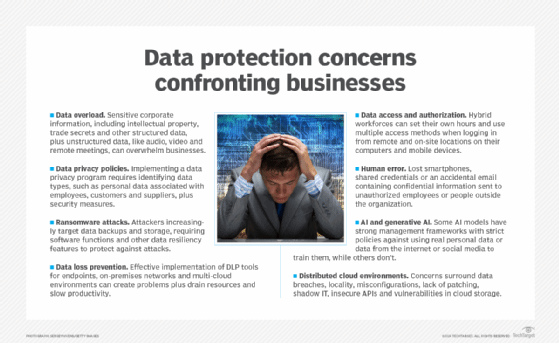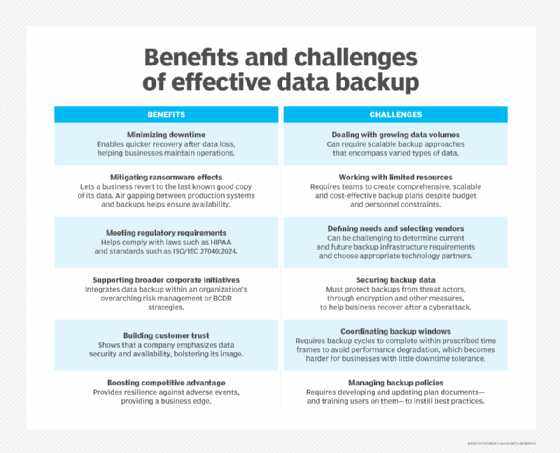Enterprise data governance: Frameworks and best practices
Data backup and recovery depend on a solid governance framework that includes procedures for data management, stewardship, quality monitoring, protection, security and compliance.
High-quality data is a necessity to succeed in a fast-paced business world. Data -- and the way it's governed -- drives strategy development at the executive level, as well as day-to-day decision-making for frontline workers.
Knowing how to build the right governance framework will help enterprises make the most of their data while preparing to overcome some of the more common data governance challenges, such as ensuring data is used responsibly. The ideal enterprise data governance frameworks build on an overarching business vision to define and understand data workflows, put the right data management tools in place and engrain data best practices "within the culture of the organization," said Scott Garner, senior consultant at Global Data Strategy.
Core components of an enterprise data governance framework
At their core, data governance efforts should be linked to business objectives, Garner added. That begins with determining what data matters the most toward achieving a specific business goal and tying data governance activities to that goal, he explained. From there, enterprises need to define roles and take steps to evaluate, secure and manage data.
Data stewardship roles and responsibilities
"Data governance should be owned by the business and enabled by IT," Garner noted. Roles should be assigned across the enterprise, including owners, stewards who ensure data is accessible and trustworthy, and stakeholders with the authority to decide data standards, enforce policies and set priorities. And they should be part of a data governance council that meets regularly. By coordinating data efforts companywide, Garner said, the council helps ensure data gets used more effectively. "Establishing clear accountability for stewardship and decision-making provides the necessary structure to orchestrate efforts."
Data quality monitoring and evaluation
Clearly defined processes are necessary to ensure any employee seeking to use data can, in fact, work with it, Garner said. Businesses should establish workflows to monitor data quality, prioritize and remediate data quality issues, and allow for potential exceptions.
They must strike a balance between leaning on their data governance council and bringing in business stakeholders, Gartner cited in its February 2025 report, "Best Practices for Aligning Data Management With Business Value." Collaboration is necessary to link key data workflows to business objectives, identify gaps and define metrics for measuring success. This type of collaboration should be a regular exercise as opposed to a one-off initiative, the report noted, as ongoing changes will help an enterprise data governance framework mature over time.

Data protection, security and compliance
Since everyone in the enterprise uses data in their everyday work, data governance principles should be applicable to all employees regardless of role, advised Katrina Ingram, CEO and founder of training and consultancy firm Ethically Aligned AI. Privacy and governance teams should take the lead on data classification, cybersecurity teams should protect the data from internal and external threats, and senior leadership should set an example for how data will be used and managed responsibly. When all employees recognize their role in supporting data governance, Ingram added, it "becomes an extension of everyone in the enterprise."
Data management processes and procedures
The adage "You can't manage what you can't measure" applies to data governance. Enterprises should define metrics ranging from how much data is used, to how quickly data can be made available, to how many data sources meet quality standards. More broadly, managing data effectively requires knowing how it flows across enterprise systems, how much it costs to run data platforms and how long it takes to build new data use cases.
As enterprises look to use data to train AI models, it's important to review each AI use case rather than attempt to make all data AI-ready, according to the Gartner report. Businesses can therefore avoid preparing data for AI or the AI use case itself that proves to be too costly or difficult to execute.
Benefits of an enterprise data governance program
Enterprise data governance, Garner reported, "provides the structure necessary for producing high-quality data. It orchestrates activities across people, process, and technology -- all working together to produce data that is trusted and reliable."
Enterprise data governance efforts should be questioned and criticized if perceived benefits are slow to develop, said Nigel Turner, principal information management consultant EMEA at Global Data Strategy. "Ensure that a governance strategy contains 'quick win' improvement projects with demonstrable business benefits to … help reinforce the business rationale," he explained.
Structure is critical, according to Gartner, especially as data leaders increasingly find themselves unable to handle ad hoc data requests and one-off use cases. An enterprise data governance framework that aligns initiatives with business outcomes, noted the research firm, builds momentum for data-driven decision-making, sets clear expectations for how the enterprise will leverage data and ensures resources are invested in the right place. Data governance also provides protection against data loss, sprawl and unmonitored duplication and helps businesses ensure they're in compliance with proliferating and increasingly stringent data protection regulations.

Challenges of an enterprise data governance program
One of the bigger pitfalls of enterprise data governance is starting with a compliance initiative, Gartner warned in its March 2025 report "How to Get Started With Midsize Enterprise Data Governance." Compliance alone doesn't "inspire the business," even when it's an executive priority, the report noted, adding that organizations should emphasize a key business initiative tied to generating growth, achieving savings or improving customer satisfaction.
Scope creep is another common challenge. From the outset, the data governance council should limit itself to identifying the business initiative, the analytics associated with it and the data that will drive the analysis, Gartner advised. Anything more than that could hinder an enterprise's data governance program and make it difficult for the council to deliver on its promise.
Even though data governance might be tied to a specific initiative, businesses should be wary of defining tactical principles. Instead, Gartner said, principles should more generally outline how and why data is collected, what it will be used for, how often it will be updated and how it will integrate with centralized data repositories.
Critically, enterprises need to ensure the collected data -- especially from customers -- is appropriate for the business initiative. In 2022, the Office of the Privacy Commissioner of Canada found Tim Hortons in violation of the nation's privacy laws. According to the investigation, the coffee chain collected consumer location information "every few minutes of every day" to provide targeted promotions for coffee and doughnut discounts. The vast amounts of collected data were deemed "not proportional to the benefits."
"You should be thoughtfully thinking through, 'Do we really need this? Is it serving our purpose? Is it necessary?'" Ingram advised. Addressing these questions upfront is critical, she added, because it's hard to reverse a corporate policy of collecting data once it's been put in place.
Tools and technologies for data governance in the enterprise
"Having a tool to enable the creation and management of conceptual, logical and physical data models is a critical first step to make enterprise data governance work," said Turner, who named three "must-have" tools for enterprise data governance:
- Data catalog. This tool automatically captures metadata, contains data definitions and standards, and helps manage changes to data sets.
- Data quality management. This function assesses data quality rules and supports the identification and reporting of quality issues. Ideally, these tools will come with dashboards that readily track quality improvement issues against a predetermined baseline.
- Data modeling. This technology identifies the critical data elements that business owners and data stewards will rely on.
Businesses also benefit by developing a semantic layer, as well as APIs to go with it, so end users can easily connect to data sources, Turner said. "This is an essential prerequisite of ensuring the data catalog can deliver its potential value in governance efforts," he explained. "Very often, critical data is held in inaccessible source systems and applications [that] can only be accessed by IT."
How to assess your enterprise data governance maturity
As enterprises make progress on their data journey, it helps to examine whether existing frameworks and data governance best practices are meeting their needs. Therefore, it's worthwhile to ask the following questions:
- Are backup and recovery policies aligned with governance classifications? Data can be classified into four types, according to Gartner's December 2024 report "Build a Foundation for Resilience With Modern Backup and Recovery": Business-critical -- core operations, data recovery plans and backup data; business performance -- service-level agreements, utilization and monitoring; business capacity -- resource planning, storage and infrastructure; and business compliance -- legal, regulatory and retention policies. Corporate policies should account for these classifications, ensuring data is backed up and restored relative to its business value.
- Do we have full visibility into sensitive and high-risk data locations? Some enterprises might operate in dangerous places because it's the nature of their business, while others could generate and use data from high-risk spots such as an infrastructure pipeline or government facility. Many businesses host backups in georedundant locations as well. To support everything from cybersecurity to data recovery to data governance, enterprises need to see where, when and how data is being accessed on a global scale.
- How do we enforce deletion and data retention policies across distributed cloud systems? The data governance council, Garner said, should have the authority to assign decision rights to the person or group best suited to define and enforce policies and draft best practices. That should help enterprises create and communicate standards and ensure customer data or other sensitive information is used responsibly.
- Who owns each major data domain, and are those owners accountable? Assigning data owners and stewards is just the first step in successful data governance, Turner said. These individuals also need time to do their job, devise well-defined performance objectives and provide proper training. Without proper support and recognition, Turner added, "governance gets pushed down their priority list and loses momentum."
Brian Eastwood is a Boston-area freelance writer who has been covering healthcare IT for more than 15 years. He also has experience as a research analyst and content strategist.








